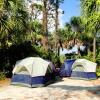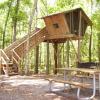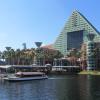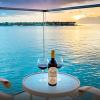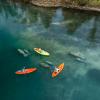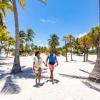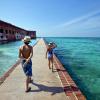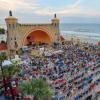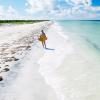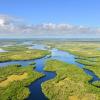Manatees in Blue Spring State Park
Carol Grant for VisitCitrus.com
Dolphin leaps above water surface - Charlotte Harbor
Scott Keeler for VISIT FLORIDA
A flamingo takes wing in the Snake Bight, in Everglades National Park
James Branaman for VISIT FLORIDA
Alligator at Gatorland
Gatorland
A Bald Eagle and an Osprey clash
Pasco County Tourism
Roseate spoonbill
Peter W. Cross
Pelican on Fort Myers Beach pier
VISIT FLORIDA
Butterfly Rainforest - Florida Museum of Natural History - Gainesville
Brad McClenny for VISIT FLORIDA
Baby sea turtle Sebastian Inlet
David DeLong for VISIT FLORIDA
From the coral reefs of the Keys to the cypress swamps of northern Florida, our diverse habitats are home to an incredible cavalcade of critters. Where else can you see reclusive alligators, playful manatees and beautifully plumed snowy egrets all in a single day?
Be an early bird, wear sunscreen and bring binoculars. Then wander slowly through our parks and nature centers and meet some real Florida natives. Here are just a few:
SEA TURTLE
Tiny tracks leave telltale signs of turtle tikes on Florida's shores. Sea turtle moms migrate great distances to return to nesting sites on both coasts, though most are located from Titusville to Sebastian Inlet. The Archie Carr National Wildlife Refuge stretching from Melbourne Beach to Wabasso has the densest population of nesting Loggerhead sea turtles in the Western Hemisphere and green turtles in the Untied States.
KEY DEER
You'll fawn over these tiny deer, just 90 pounds and 2½ feet tall. Most of the remaining Key deer live in globally imperiled pine rocklands in National Key Deer Refuge, but are also visible on Big Pine and No Name Keys as well as surrounding islands. They are most active at dusk and dawn. Feeding them puts them at risk... be a dear and don't.
MANATEE
When Christopher Columbus first saw a manatee, he thought it was a mermaid. These gentle vegetarians grow to ten feet long, weigh 1,000 pounds and are related to the elephant. Manatees head for warm waters in winter and can be seen in rivers, inlets, springs and near power plants. Choice viewing locations include Blue Spring State Park, which is a designated Manatee refuge, Homosassa Springs State Wildlife Park and Crystal River National Wildlife Refuge.
DOLPHIN
Dolphins are warm blooded, air-breathing mammals with communication skills and social style. See them from our shores or by boat, from the Gulf Islands National Seashore in Pensacola to the Florida Keys Marine Sanctuary.
ALLIGATOR
An alligator can chomp down its toothy jaws with a 3,000-pound snap. This official state reptile averages six to twelve feet in length and can sprint with blurring speed. Alligators can be safely spotted at many of our parks and wildlife refuges, including Myakka River State Park in Sarasota and Everglades National Park. Lake Jesup in Oviedo is 100,000 years old and boasts 9,000 alligators, the largest number of alligators per square mile of any lake in Florida.
CROCODILE
Crocs have narrower snouts than alligators, grow slightly larger and shy from human contact. This rare prehistoric animal lives in the Everglades and in the upper Keys.
NORTHERN RIGHT WHALE
The grand sight of a whale splashing in the water is not usually associated with Florida. But northern right whales choose our northeastern coastal waters, almost exclusively, to give birth in winter months. They are among the most endangered species of large mammals in the world.
Look for them at the Canaveral National Seashore and Fort Clinch State Park. Northern Right Whales have been reported about 10 miles offshore from the fort.
FLORIDA BLACK BEAR
Like Winnie the Pooh, Florida black bears love honey - but also honeybees, fruits, nuts, twigs and small animals. These timid teddies have curved claws for climbing the trees of our national forests. See them safely from the boardwalk at Corkscrew Swamp Sanctuary in Naples.
FLORIDA PANTHER
Though shy and seldom seen, Florida panthers are usually found in the pinelands, hardwood hammocks and mixed swamp forests of the Everglades and adjacent wildlife refuges, including the Florida Panther National Wildlife Refuge in Naples. This cool cat is actually a subspecies of cougar.
BOBCAT
Named for their short or "bobbed" tail, these fascinating felines are larger than house cats and sport razor sharp teeth and claws. The bobcat prefers woody or grassy areas, but can be seen along deserted roads at dawn and dusk hunting for small rodents. Look for them at St. Marks National Wildlife Refuge near Tallahassee and Wekiwa Springs State Park near Orlando.
ROSEATE SPOONBILL
Florida's "real" pink bird has a brilliant fuchsia body with a bright red shoulder patch and a long, flat bill. A roseate sighting ranks high in a birdwatcher's pecking order and occurs largely in South Florida. The J.N. "Ding" Darling National Wildlife Refuge on Sanibel Island is home to many of these blushing beauties.
PRETTY IN PINK
It's hard to imagine Florida without flamingos. The pink-plumed people pleaser is even the symbol of the state lottery. But the truth is there's a better chance of seeing the plastic variety on a lawn than the real bird in the wild. You will see plenty at our state parks, sanctuaries and zoos, where the non-Florida natives have found happy homes.
PELICAN
The pelican has a large throat pouch that holds three times more fish than its stomach. These robust birds live at our beaches and waterways and at the Pelican Island National Wildlife Refuge in Sebastian.
BALD EAGLE
A national symbol since 1782, this true American bird is the only eagle unique to North America. The southern variety favors feathering its nest in Florida - The Prairie Lakes Unit of Three Lakes Wildlife Management Area has the highest concentration of nesting bald eagles in the lower 48 states. See them also at Marco Island, an official Bald Eagle Sanctuary.
FLORIDA'S BEAUTIFUL BUTTERFLIES
Brilliantly colored in striking patterns, Florida's butterflies are like flowers in flight. Our warm weather and perennial blooms provide a heavenly habitat for the winged beauties; nearly 200 species are found here. The zebra longwing, easily identified by its long black and yellow striped wings, is the official state butterfly. This friendly flutterer can be seen statewide any time of year. It doesn't startle easily and might even be coaxed to perch on your finger. The large and lovely monarch is another favorite of butterfly fans. A strong flier, it flaps its bright orange and black wings slowly, then glides like a bird. This colorful creature and year-round resident is joined by its northern counterparts when they travel south through northern Florida to winter in Mexico. The St. Marks National Wildlife Refuge in Northwest Florida holds a butterfly festival every October to celebrate the thousands of monarchs that migrate there each fall.


